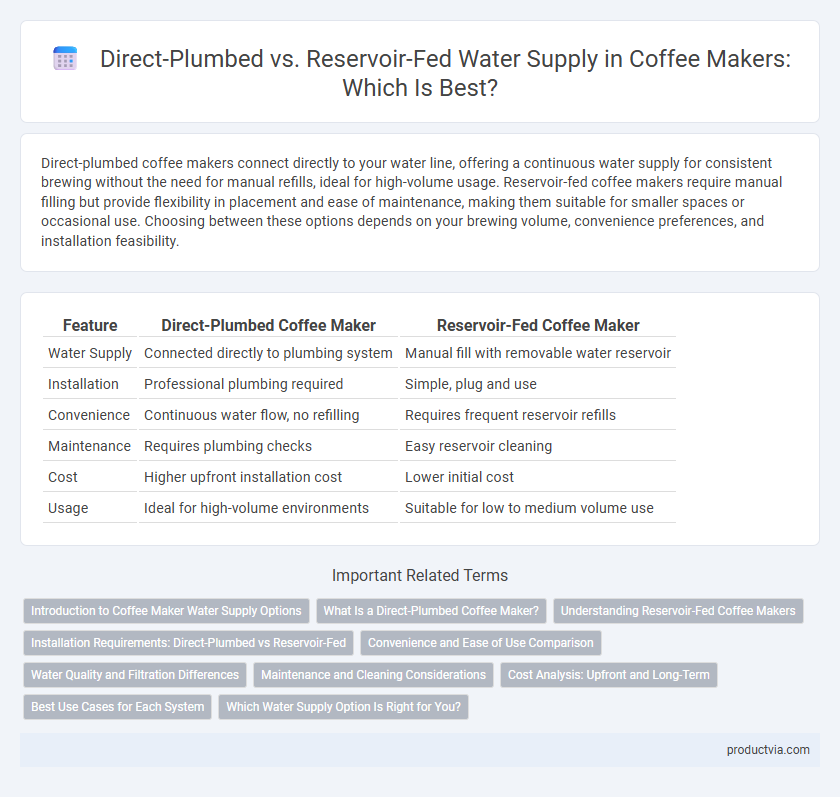Direct-plumbed coffee makers connect directly to your water line, offering a continuous water supply for consistent brewing without the need for manual refills, ideal for high-volume usage. Reservoir-fed coffee makers require manual filling but provide flexibility in placement and ease of maintenance, making them suitable for smaller spaces or occasional use. Choosing between these options depends on your brewing volume, convenience preferences, and installation feasibility.
Table of Comparison
| Feature | Direct-Plumbed Coffee Maker | Reservoir-Fed Coffee Maker |
|---|---|---|
| Water Supply | Connected directly to plumbing system | Manual fill with removable water reservoir |
| Installation | Professional plumbing required | Simple, plug and use |
| Convenience | Continuous water flow, no refilling | Requires frequent reservoir refills |
| Maintenance | Requires plumbing checks | Easy reservoir cleaning |
| Cost | Higher upfront installation cost | Lower initial cost |
| Usage | Ideal for high-volume environments | Suitable for low to medium volume use |
Introduction to Coffee Maker Water Supply Options
Direct-plumbed coffee makers connect directly to the water line, providing a continuous water supply for high-volume environments and ensuring consistent brew quality. Reservoir-fed models rely on manually filled water containers, offering flexibility and ease of installation suitable for lower usage settings. Choosing between direct-plumbed and reservoir-fed systems depends on factors like installation complexity, maintenance requirements, and usage frequency.
What Is a Direct-Plumbed Coffee Maker?
A direct-plumbed coffee maker connects directly to a building's water supply, providing a continuous flow of fresh water without the need for manual refilling, which ensures consistent brewing and reduces downtime. This system is ideal for high-volume environments like offices or cafes, where convenience and efficiency are crucial. Unlike reservoir-fed models, direct-plumbed machines eliminate the risk of water stagnation and improve overall hygiene by maintaining a closed water loop.
Understanding Reservoir-Fed Coffee Makers
Reservoir-fed coffee makers feature a built-in water tank that users manually fill, offering flexibility and portability without requiring a permanent plumbing connection. These machines are ideal for home use or small offices, as the water reservoir typically holds enough volume to brew multiple cups before needing a refill. Reservoir-fed systems also simplify maintenance and installation compared to direct-plumbed coffee makers, which rely on a continuous water supply line and professional setup.
Installation Requirements: Direct-Plumbed vs Reservoir-Fed
Direct-plumbed coffee makers require professional plumbing installation to connect directly to the water supply, ensuring a continuous flow without manual refilling. Reservoir-fed machines offer flexible placement with no plumbing needed, as users manually fill the water tank. Installation complexity and ongoing maintenance costs are significantly higher for direct-plumbed systems compared to the simple setup of reservoir-fed models.
Convenience and Ease of Use Comparison
Direct-plumbed coffee makers offer continuous water supply without manual refilling, providing unmatched convenience for high-volume use in offices and cafes. Reservoir-fed models require periodic refilling but offer flexibility in placement and simpler maintenance, making them ideal for home kitchens. Choosing between the two depends on balancing uninterrupted operation with ease of setup and cleaning.
Water Quality and Filtration Differences
Direct-plumbed coffee makers connect to a water line, providing a continuous supply of fresh water that often passes through built-in filtration systems to reduce chlorine, sediment, and impurities, ensuring consistent water quality. Reservoir-fed machines rely on manually filled tanks, making water quality dependent on the source used, which may require external filtration to achieve optimal taste and purity. Filtration in direct-plumbed systems tends to be more robust and automated, minimizing maintenance while reservoir-fed units demand regular cleaning and careful water selection to prevent mineral buildup and contamination.
Maintenance and Cleaning Considerations
Direct-plumbed coffee makers require regular inspection of water lines and filters to prevent scale buildup and ensure consistent water quality. Reservoir-fed models demand frequent emptying, refilling, and sanitation of the water tank to avoid bacterial growth and mineral deposits. Both systems benefit from routine descaling and cleaning cycles to maintain optimal performance and extend machine lifespan.
Cost Analysis: Upfront and Long-Term
Direct-plumbed coffee makers require higher upfront costs due to professional installation and plumbing modifications but reduce long-term expenses by providing a continuous water supply, eliminating the need for frequent refills. Reservoir-fed machines offer lower initial investment and flexibility but incur ongoing costs from manual water refilling and potential maintenance related to water quality inconsistencies. Assessing cost efficiency depends on usage volume and operational scale, where direct-plumbed systems benefit high-demand environments, while reservoir-fed models suit lower-volume or portable needs.
Best Use Cases for Each System
Direct-plumbed coffee makers are ideal for high-volume settings like offices or commercial spaces where continuous water supply ensures consistent brewing without refilling. Reservoir-fed models suit home environments or small cafes, offering flexibility and ease of use without installation requirements. Understanding water supply needs helps optimize coffee freshness and operational efficiency.
Which Water Supply Option Is Right for You?
Direct-plumbed coffee makers connect directly to your water line, ensuring a continuous supply for high-volume use, ideal for offices or busy cafes. Reservoir-fed models require manual refilling but offer flexibility and ease of installation, making them suitable for home use or low-traffic environments. Consider your daily coffee demand, installation constraints, and maintenance preferences when choosing between direct-plumbed and reservoir-fed water supply options.
Direct-plumbed vs Reservoir-fed for water supply Infographic

 productvia.com
productvia.com